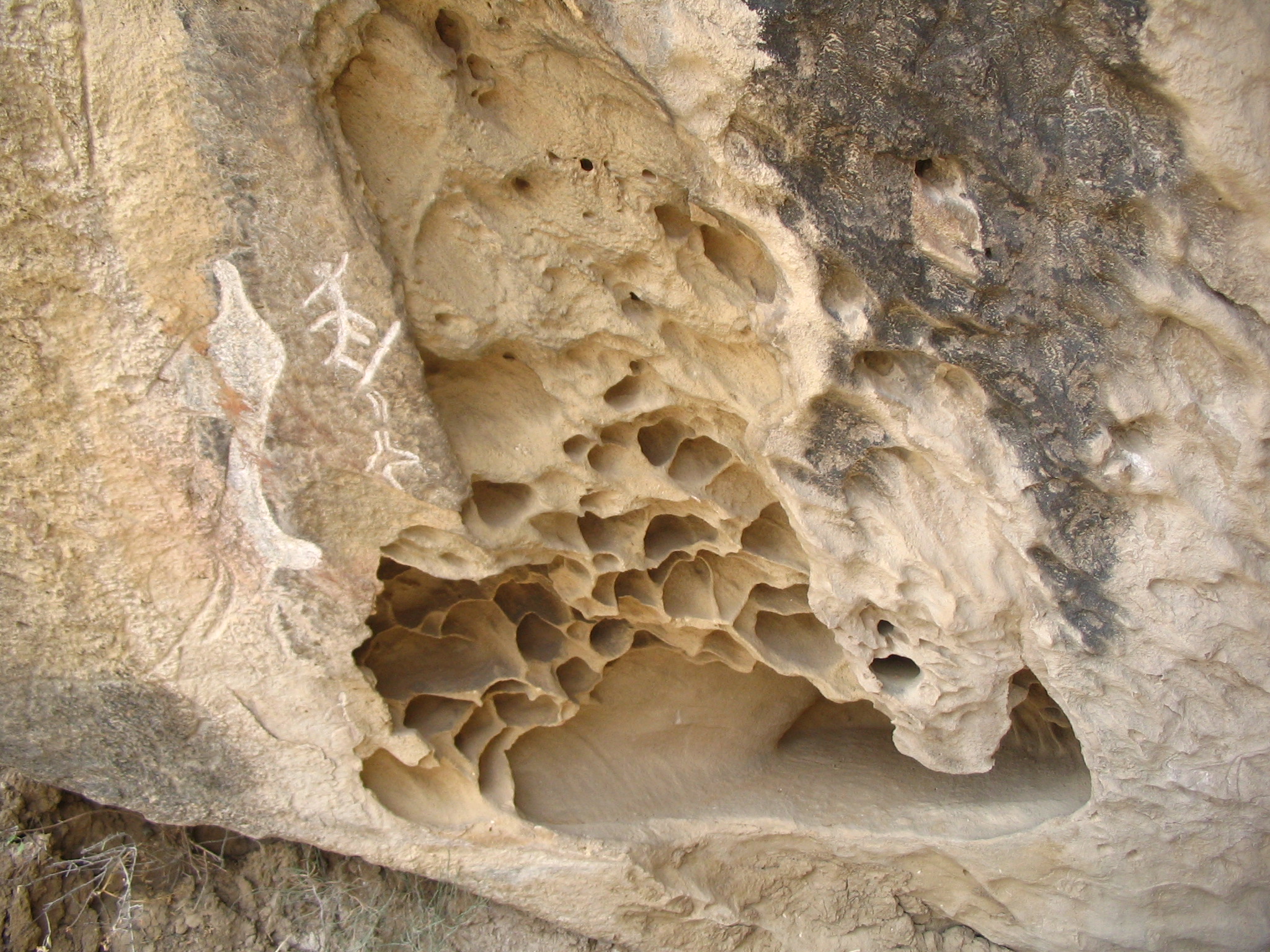Saving the Stone Age
Researchers are fighting to protect architecture and art from salt
Nicole J Lou • November 3, 2014

Salt has damaged sandstone –and rock art – over the years in the Gobustan National Park of Azerbaijan. [Image credit: Wikipedia Commons]
When Eric Doehne arrived at the historic Lummis House in Los Angeles, he immediately knew his patient was in bad shape. The evidence was splayed on the walls and there appeared to have been intruders from outside. Doehne saw hope for his patient, even though the culprits left behind a dire scene. They were known for having attacked around the world, famously making several attempts inside the Sistine Chapel. These intruders were mere salt crystals.
Stone, brick and cement appear to be strong, sturdy materials. But these building blocks of human civilization are porous and susceptible to damage by something as small as salt. And though archeologists and architectural conservators have long known that salt damage is one of the main causes of building deterioration, only recently have researchers developed a method to estimate its extent, said George Scherer, an expert on salt weathering at Princeton University in New Jersey and a collaborator on the project.
By working with Robert Flatt, a building materials scientist at Swiss Federal Institute of Technology Zurich, Scherer found that the amount and the type of accumulated salt are among the variables that predict the stress that the salt causes to stone. When salts enter stone pores and form crystals, they exert pressure from inside the stone and force it to break apart. They have cracked open architectural wonders such as Petra in Jordan and the Alhambra in Spain.
Doehne is the historic materials conservator working on the restoration of the Lummis House. This historic home and museum in northeastern Los Angeles dates back to 1896 and belonged to Charles Fletcher Lummis, an eccentric journalist who was instrumental to the preservation of deteriorating Spanish missions in California.
Doehne found salt trails on the interior walls and discovered that – unlike modern buildings – the house didn’t have damp proof courses, which are simple barriers placed a foot above the foundation of a building to prevent groundwater from traveling up the walls through capillary action. “Early masonry buildings don’t have this so they tend to be damp, because brick and mortar suck up moisture from the ground,” he explained.
Doehne likens his restoration work to medical diagnostics. To restore an old stone structure, he digs into his patient’s history to understand how it got to its current condition.
Part of Doehne’s examination is determining how salt is drawn into a stone structure. Groundwater can climb up stone buildings and leave a salty trail after the water evaporates. Structures in marine environments may also absorb the salty sea air. And plant fertilizers often contain nitrate salts and sulfate salts that eventually make their way into buildings.
The winter season also brings plenty of salt weathering. Salts used for de-icing public passageways eventually find their way to stone structures. The damage is visible on “any sidewalk and [at] the base of any building in New York,” said George Wheeler, an expert on stone conservation at Columbia University in New York.
Salt damage is particularly vexing for archeologists who preserve historic artifacts and monuments. According to Wheeler, archeologists working in the annually flooding regions of the Nile River in Egypt find that their excavations can damage clay and stone objects once they are lifted from the ground. Their sudden exposure to air induces a drying process that causes salt crystallization. Salt has damaged Egyptian tombs, artifacts and temple walls this way.
But conservators are not sitting idly by while salt destroys our buildings and objects, erasing our cultural heritage. They work not only to prevent salt damage, but also to reverse it by salt removal.
Museums have struggled with salt appearing on drying objects for a long time. For more than 100 years, Wheeler said, museums have fought it by immersing objects in water over and over until the salt is removed. This approach is risky for clay objects, however. “Clay can cause damage in the wetting and drying process,” he explained.
Doehne provides a different treatment for some of his salt-weathered patients. A sticky mixture including clay, paper pulp and sand can act like a giant sponge and suck the salt off stone walls, he said. Conservators have recently figured out that if the ingredients of the salt sponge are tweaked for individual cases, it will leave little or no residue on precious structures.
Some scientists, however, are skeptical of the long-term benefits of removing salt from stone. Heather Viles, director of the Oxford Rock Breakdown Laboratory at Oxford University in England, argued that while salt sponges can be useful, they don’t solve the underlying problem of removing the salt’s source. “If you remove stone and replace stone, it’s amazing how much the new stone will suck in the salt again,” said Viles.
Scientists are now experimenting with different ways to defend stone structures from salt weathering. “The good news is there are more original avenues being pursued now than ten years ago,” Scherer said. “People have tried making the stone stronger but that’s just treating the symptoms. Now the alternatives are either to make the salt stop crystallizing, or to allow the salt to crystallize without causing stress.”
If researchers don’t produce a long-term defense against salt, many of the world’s historic monuments may eventually disappear. “It took me a long time to figure out how the heck salt weathering works,” Doehne said. “It’s so hard to see that something so insignificant can cause so much damage to cultural history.”